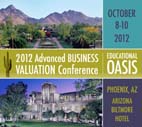
| June 6, 2012 | Issue #117-1 |
Working draft on customer-related assets is ready Yesterday the Appraisal Practices Board (APB) of The Appraisal Foundation issued the working draft of Valuation of Customer-Related Assets. Comments are due by July 31, 2012. Any questions on the draft, contact Paula Douglas Seidel at paula@appraisalfoundation.org. Oracle v. Google is over (for now), leaving case law that could change patent damages After more than two weeks of trial and deliberations, the jury rendered a verdict of noninfringement on all counts in the epic Oracle v. Google litigation. More importantly, on May 29, the district court denied Oracle’s request for a judgment as a matter of law, finding “ample” evidence to support the jury’s decision and dismissal of claims. The next day, the judge also ruled that the Java application programming interfaces (APIs) were not subject to copyright. Taken together, the rulings have led some patent experts to conclude that software—which consists largely of mathematical algorithms—has no value except to provide “a list of ways a lawyer can assert that the patent has been infringed.” “Patents and software need to get a divorce before somebody gets hurt,” agrees another blogger, who posted daily updates from the courtroom. “The damage from software patents is astounding, and the IP is so puny. There is an imbalance in the legal universe, and it needs fixing. Software is algorithms, and that is mathematics, and it's wrong, totally wrong, to let math be patented. These patents should never have been issued.” Five Daubert opinions. Oracle has promised to appeal the rulings. In the meantime—and of particular interest to IP appraisers and damages experts—the case has also produced five Daubert opinions on damages: three against the plaintiff’s expert, one against the court-appointed expert, and one against the defendant’s rebuttal experts. Key takeaways include:
So far, we’ve already digested three of the Daubert decisions in the Business Valuation Update and posted copies of the court's respective opinions at BVLaw. We’ll have the remaining two case digests in the July 2012 issue, with posting of these opinions as well. Fair value measures during downturn prompting ‘dramatic increase’ in PCAOB audit deficiencies, says new Acuitas study “Our firm recently performed a study of inspection reports by the PCAOB,” says Mark Zyla (Acuitas), referring to the Private Company Accounting Oversight Board. The new study, Survey of Fair Value Audit Deficiencies, found that the most common reason for the “dramatic increase” in audit deficiencies relates to fair value measurements (FVM), either in the audit of the measurement or the testing for impairment, particularly of financial instruments. According to the study’s executive summary:
The study found 123 audit deficiencies related to fair value estimates and asset impairments in 2010 PCAOB inspection reports, compared to 72 deficiencies in 2009, says an online writer for the Wall Street Journal. “The PCAOB is saying that the auditors in certain situations didn’t provide enough scrutiny in terms of management’s forecasts,” Zyla told the WSJ, “or [they] didn’t look closely enough at the assumptions and methodologies that went into some of the modeling used by corporate pricing services.” Finnerty publishes new put-option model of marketability discount “Previous work on Rule 144 stock derived an upper bound on the value of the marketability option by modeling it as a put on the maximum stock price over the restriction period,” says the abstract to a new article by John Finnerty (Finnerty Economic Consulting), just published by The Journal of Derivatives. “But an investor would require perfect foresight to actually attain that upper bound.” In his article “An Average-Strike Put Option Model of the Marketability Discount,” Finnerty argues that “a better assumption is that the investor has no special timing ability, so the option to sell should be closer to a put on the average price.” In using this model, Finnerty finds that it tends to understate the observed marketability discount, but the theoretical option value is highly significant in regressions on the discount in over 200 private placements. To access the complete article, click here (subscription or single purchase required). Current concepts of goodwill are ‘archaic’ and inconsistent “The current legal approach to goodwill is archaic,” writes attorney Richard Orsinger (McCurley Orsinger McCurley Nelson & Downing) in a lengthy paper presented at the recent AAML/AICPA National Conference on Divorce in Las Vegas. The legal concept of goodwill arose over 200 years ago, when a business’s income—in excess of its return on tangible assets and labor costs—was attributable to its location, the reputation of its proprietor and products, and the personal relationships between the companies’ owners, employees, and customers. “Current accounting practices, and the law that applied to goodwill, fail to isolate the earnings attributable to unidentified intangible assets of the business, including the business’s human capital and social capital,” Orsinger writes. “Instead, all unallocated excess earnings are attributable to a residual category called ‘goodwill,’ which offers no aid to those who are tasked with dividing that residual category into subparts.” In other words, business valuators often assume the difficult task of identifying and differentiating between the enterprise goodwill of a marital business and the personal goodwill of the proprietor, frequently “without proper guidance from either accounting principles or the law.” What’s a business appraiser to do? Tune in tomorrow, June 7, for Personal vs. Entity Goodwill, a 100-minute webinar on the current state of valuing goodwill in divorce and other scenarios, including valuing noncontrolling interests, covenants not to compete, and the transfer of personal goodwill, featuring Jim Alerding (Alerding Consulting) and Stacy Collins (Financial Research Associates), Good news/bad news on BB/BVR salary survey The good news: After an extended period of uncertainty, your BV practice is once again terrifically busy. The not-so-good news: You haven’t had time to participate in the 2012 Borrowman Baker/BVR Salary Survey. The best news: The deadline for data entry has been extended to June 29. BV firm leaders want the most credible, current, and comprehensive compensation data for their practices; the only way to ensure that they get it is to include their data in the mix. Don’t wait. Do it now. You’ll be glad you did, when it comes time to hire new talent to keep up with your expanding business. Go to the Welcome Page and begin. Updates on the TAF’s four working groups, plus a free BV glossary of terms from E&Y’s Aaron The Appraisal Foundation (TAF) staff is currently preparing a white paper to document the recent roundtable on business valuation and address SEC concerns regarding the unity (or lack thereof) of the valuation profession and its standards, reported Tony Aaron (Ernst & Young) at the recent ASA Fair Value Conference in Los Angeles. Other updates from Aaron:
In addition, Aaron presented ASA attendees with two glossaries of terms that he has been putting together over the years, one related to the world of valuation and appraisal and the second related to accounting. He has graciously offered to make the glossaries available to the greater BV community on our free resources page. Anyone with additional terms is invited to email him at anthony.aaron@ey.com. FAF approves private council, seeks nominations for members Last week the board of trustees of the Financial Accounting Foundation (FAF) issued its Final Report on Establishment of the Private Company Council. “After seeking and considering public comment,” says the executive summary, the FAF “will establish a new body to improve the process of setting accounting standards for private companies. The new group, the Private Company Council (PCC), will be overseen by the trustees and will replace the existing Private Company Financial Reporting Committee, following an appropriate transition period.” Last Friday, the FAF issued a call for nominations to the new PCC. Along with “a strong appreciation for the importance of independent standard setting for financial accounting and reporting,” the FAF is seeking applications from “CPA practitioners from national, regional, and local firms.” More information is available at its website. ASA works hard to define its strategic plan and brand In the latest e-update to members, Bob Morrison, vice chair of the ASA’s BV committee, admitted that his fellow members had “struggled” to identify the differentiators between the ASA and other BV accrediting organizations. “If we can’t verbalize them, how can we expect the public, especially the buyers of our services, to know and value them?” As a result, its Strategic Planning Task Force recently identified several distinctions, among them:
Despite these differences, ASA members seemed to have stalled at a certain level of accreditation. A recent member survey revealed that lack of funds to pay for further education and the ease with which other organizations offer credentials may be the culprit, as was the stringency of the report and expertise requirements. To help clarify recent changes to these requirements, Trey Stevens, the BVC’s vice chair of the board of examiners, is rewriting the ASA BV candidate submission guidelines and will soon publish an article that describes common flaws and errors found in submitted reports. As part of its strategic plan, the ASA will still hold “world class conferences.” Take advantage of early bird pricing for the ASA 2012 Advanced BV Conference in Phoenix from October 8 to 10; for more information, click here. Read the proposed revisions to next edition of USPAP The Appraisal Standards Board (ASB) has just issued the first exposure draft of proposed revisions for the next edition (2014-2015) of the Uniform Standards of Professional Appraisal Practice (USPAP). This exposure draft includes a proposal to retire Standards 4 and 5 as well as proposed revisions to:
Download the first exposure draft here; written comments requested by July 6, 2012. New guidance on preserving ESI in bankruptcy Although the 2006 amendments to the Federal Rules of Civil Procedure specifically addressed electronically stored information (ESI), bankruptcy courts and professionals, including insolvency experts, have had little in the way of bankruptcy-specific guidelines for managing ESI and electronic discovery issues. As a result, the ABA commissioned the ESI in Bankruptcy Working Group to study and prepare guidelines on the scope and timing of a party's obligation to preserve ESI in bankruptcy cases. The working group recently published its interim report and is currently inviting review and comments from a wider audience regarding how ESI issues should be handled in large as well as middle-market and smaller Chapter 11 cases and others. CPE on COC On June 14, join Kevin Yeanoplos (Brueggeman and Johnson Yeanoplos) and Mark Dietrich for Industry-Specific Issues in Cost of Capital Determination, an in-depth examination of how industry-specific factors of risk, capital structures, competition, regulation, and other key attributes and influences affect cost of capital determinations, with particular focus on the construction and healthcare industries.
To ensure this email is delivered to your inbox, please add editor@bvwire.com to your e-mail address book. We respect your online time and privacy and pledge not to abuse this medium. To unsubscribe to BVWire™ reply to this e-mail with 'REMOVE BVWire' in the subject line or use the link below. This email was sent to %%emailaddress%% Copyright © 2012 by Business Valuation Resources, LLC |
|




